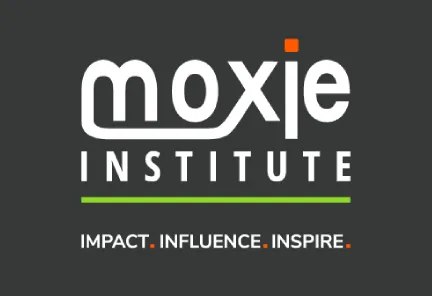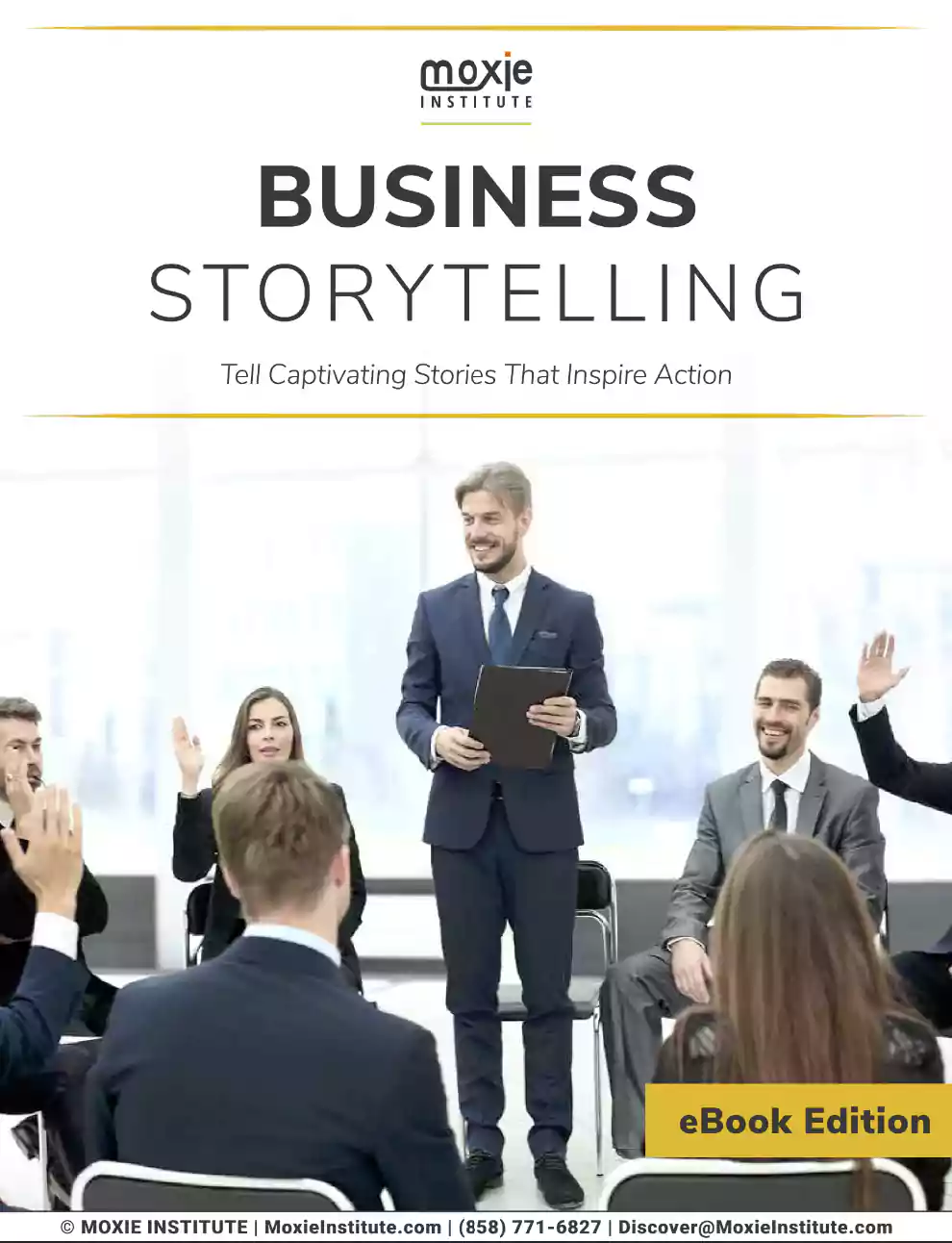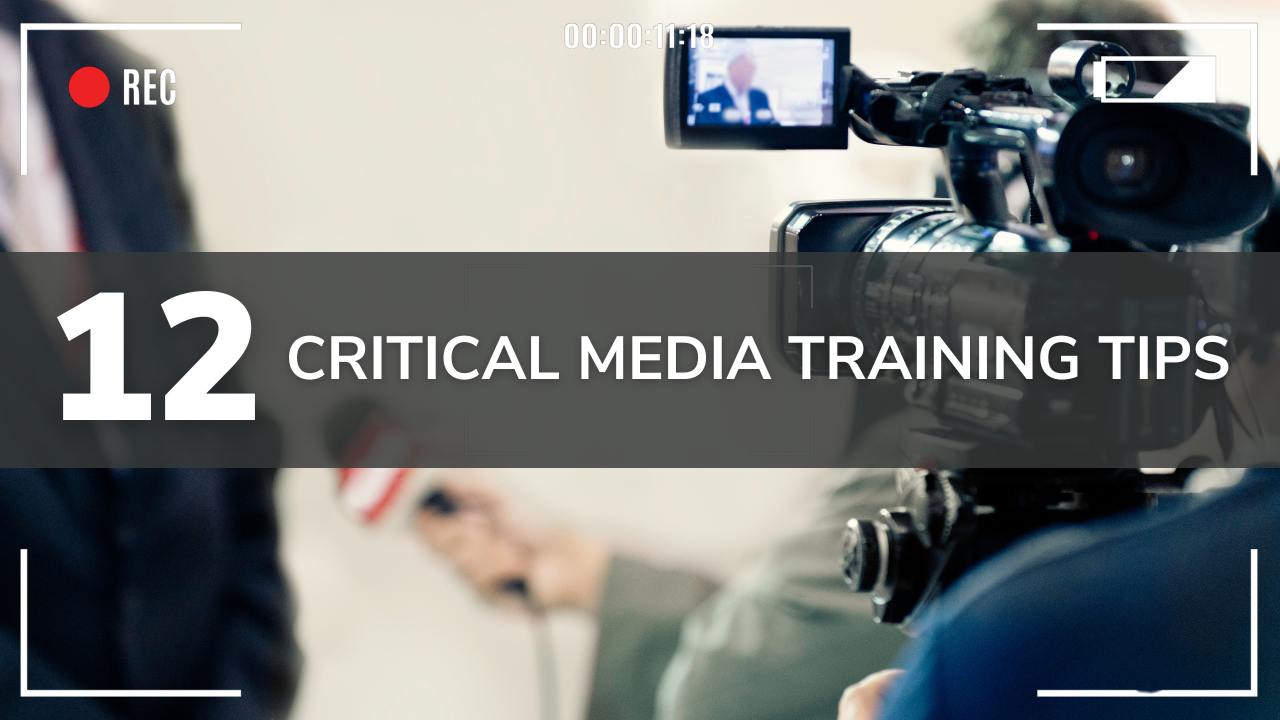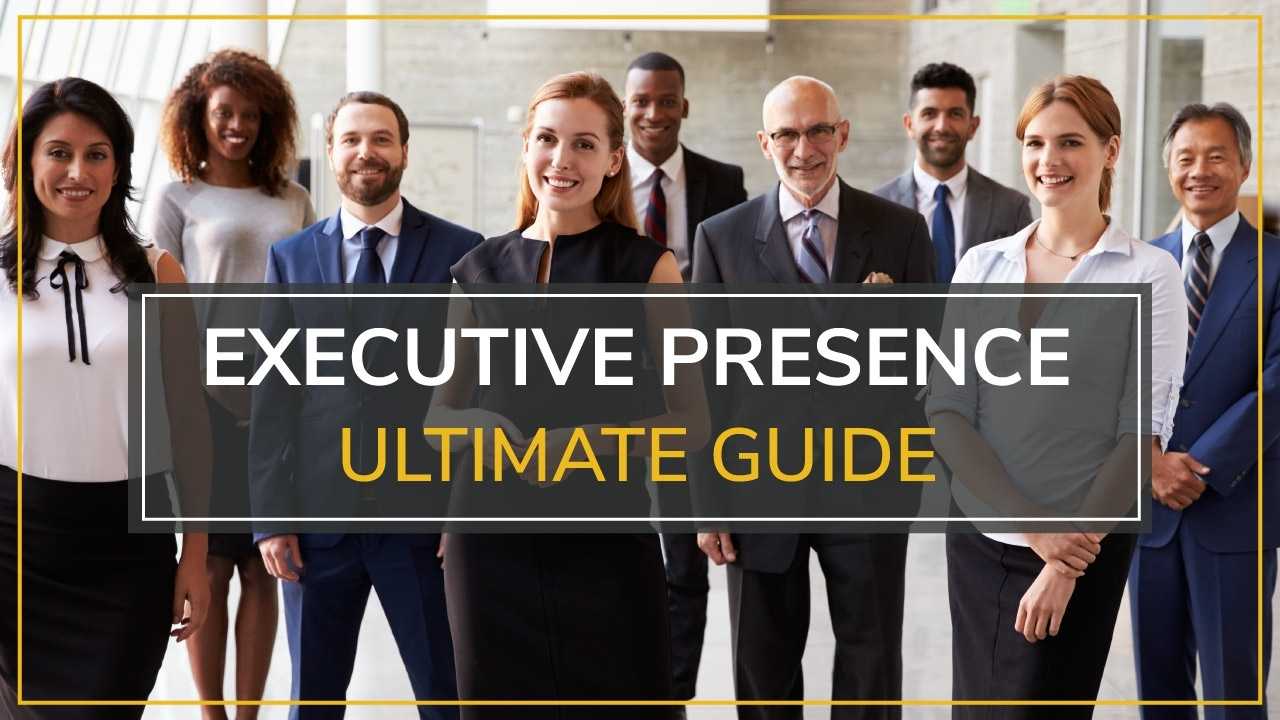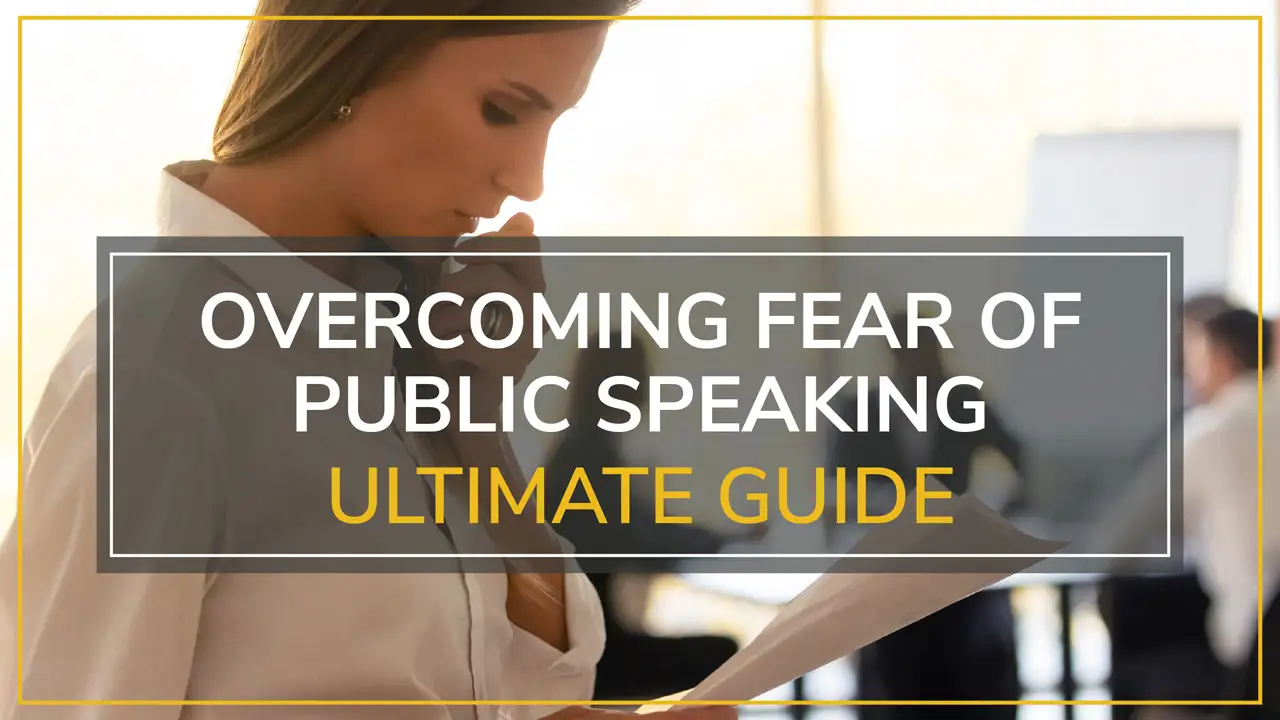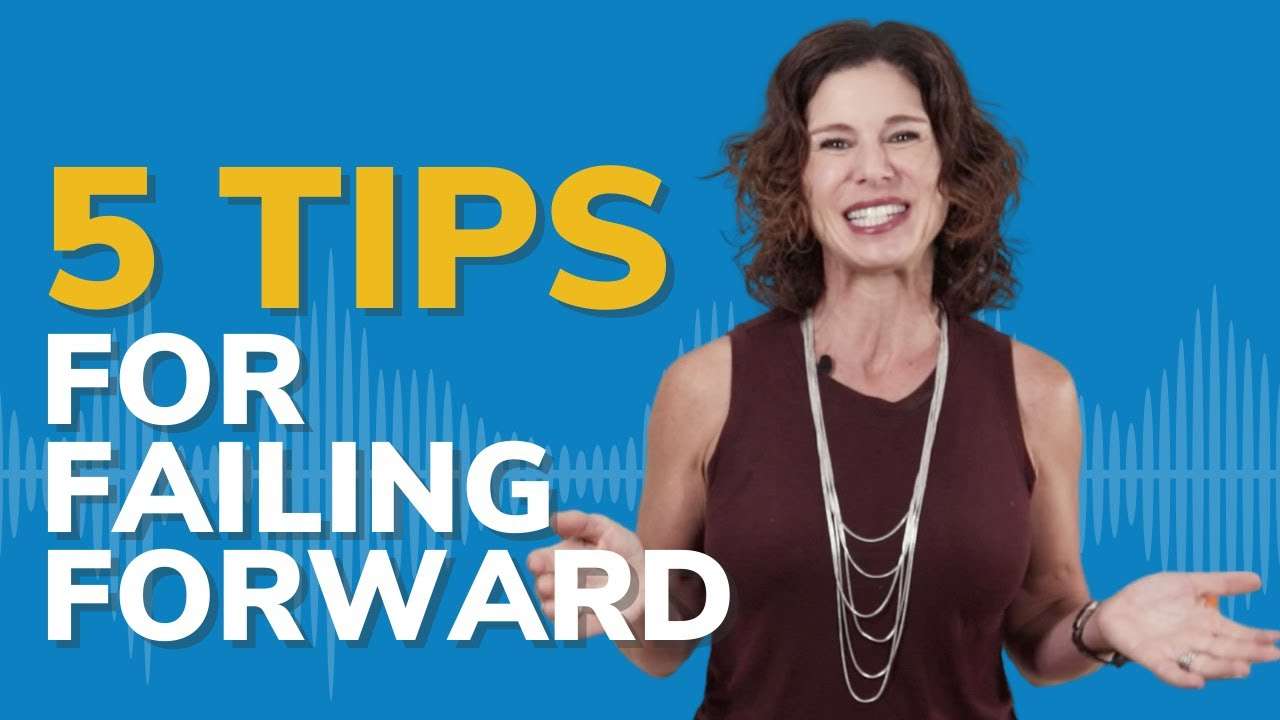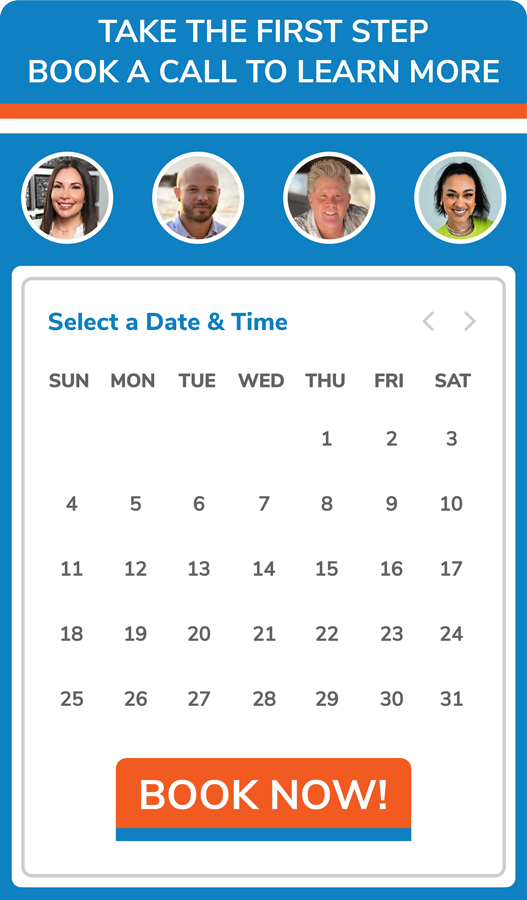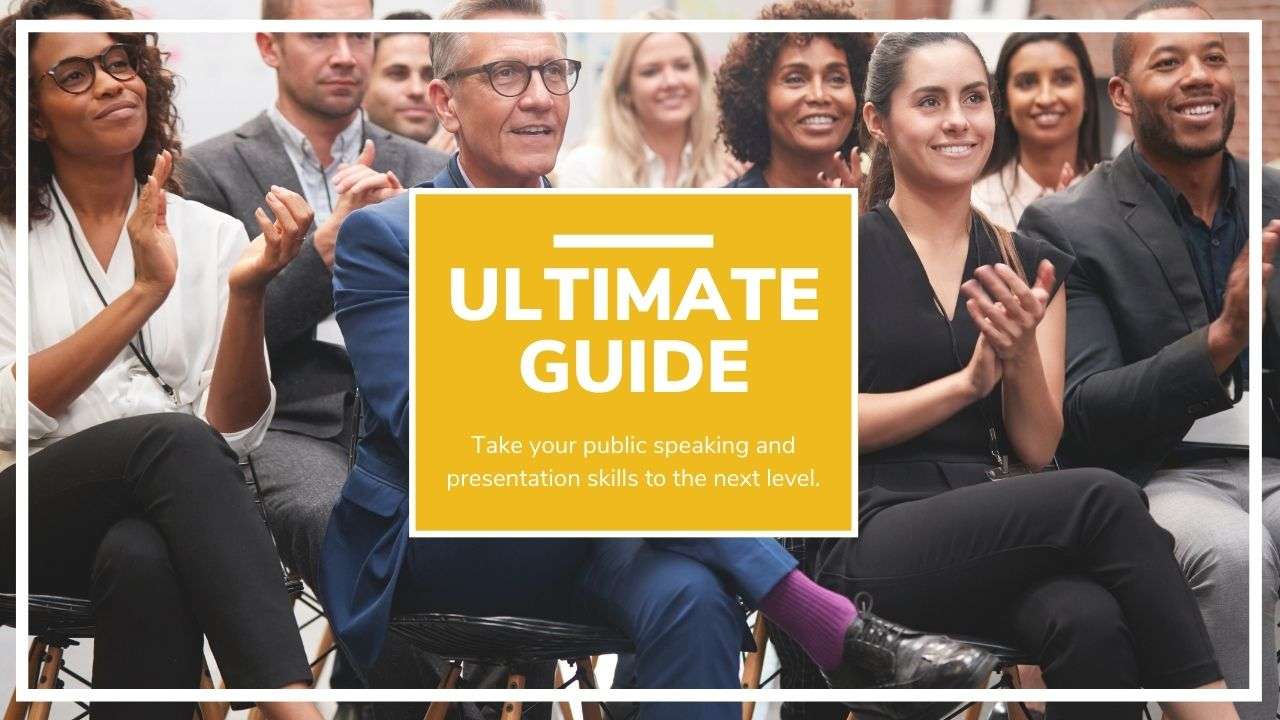A successful media appearance can spell great success. It can also mean disaster or humiliation
Dealing with the media is no simple affair. There’s an overwhelming tide of outlets using a variety of content styles from podcasts and webinars to live events and interviews. So knowing how to handle each aspect of interacting with the media will nudge you closer to success.
The following 12 media training tips provide the key insights from each of the media training blogs that Moxie Institute has already published.
This blog lets you get a bird’s eye view of things so you don’t have to do a deep dive unless you need to. Obviously if anything leaves you saying “I need to know more!” you’ll be able to investigate the full corresponding blog.
Table of Contents
Toggle1 - Pinpoint Accurate Audience Analysis
Appearing before the media means that a larger audience will hear you. But to be successful, you want to reach that larger audience with a message that resonates.
Taking the time to conduct a little audience analysis will ensure that your message doesn’t land on deaf ears (or idle wallets).
- Consider Your Audience’s Expectations
On the other side of that camera are people that are going to be “hungry” for something. It’s your job to figure out what that is and give it to them. - How Much Do They Already Know?
Is this group of people going to be familiar with you, your message, and the industry you represent? Or is this going to be a new world to them where you’ll have to give them a tour before you give them the pitch? - Consider The Demographics
Your audience’s age, gender, religion, ethnicity, class, occupation, education, etc. will all inform how you should aim to come across. The demographics of your audience will determine how likely your audience will either support what you say or oppose it, so it’s imperative that you use the right words with the right group of people. - Get On Your Goals
You want people to either do something, think something, or feel something by the time your media appearance is over. So nail down some specifics.- Are you drawing attention to a particular problem or issue?
- Are you trying to build your credibility as an expert in your field?
- Depending on the format of the media appearance, what questions could you face and what answers could you offer?
- Take Them On A Journey
Now that you know what kind of people that will be listening, craft content for them with this basic progression in mind:- What (What it is)
- So What? (Why it matters)
- Now what? (What they’re supposed to do)
- Keep Them Locked In
Holding an audience’s attention in person is hard enough. How are you going to manage it through the mass reach of the media? Leverage storytelling where and whenever you can, and don’t forget to sound—and look—interested in your own message.
2 - Nonverbal Communication That Projects Confidence
The camera isn’t a very expressive listener.
It just stares at you with that unblinking lens. The temptation is to reciprocate that look while speaking. But don’t forget that your very-human audience is watching what that camera sees.
They need to see a poised, confident speaker representing a brand that they need. Nonverbal communication is your key to getting there. You’ll look and feel the role that got you in front of the camera.
- Own the Space
Standing motionless will make you look cornered and/or robotic. Confident speakers are comfortable enough to move their bodies and express themselves.If it applies, be sure to check with the production team where you can and can’t move. You don’t want to accidentally walk off-camera!
- Signal Openness and Power
Even if you can’t move around much, you can use plenty of gestures and good posture.Whether sitting or standing, have your shoulders back and a straight posture. If standing, ground yourself with feet planted firmly on the floor when you’re not moving. Look like you feel good about yourself and your viewers will feel good about you, too.
Be natural with your hand gestures. The movement is a part of communication, so don’t be afraid to be spontaneous and “go with the flow.”
Again, check with production where you need to be so that everything you do will be within the view of the camera. You don’t want to gesture outside of the camera’s eye.
- You’ve Got a Face—Use it!
The overall movement of your body is important, but your face will be taking center stage. So the use of facial expressions is essential. Smile as naturally as possible.But what if your media appearance is audio-only, such as a podcast? Still use facial expressions just as you would on-camera. People trained in over-the-phone sales are instructed to smile because it influences one’s tone of voice and state of mind.
People will be able to “hear” your facial expressions.
- Keep Good Eye Contact
If you have a live audience with you for your media appearance, make eye contact as you would during any other presentation. Not boring into them with a laser-focused stare, and not avoiding eye contact either. Otherwise, direct these efforts to your host and other speakers.If you’re required to speak to a camera, the lens is where you need to look to simulate that connection with a live speaker.
- Keep The Energy Up
Celebrities don’t get too relaxed when they’re on camera, do they? They’re loud, they’re lively, they’re nearly volcanic with the energy they’re delivering.That’s because energy is contagious. They want you to get swept up in the feelings they’re radiating. You want to have the same effect on your audience. Strong emotions for you will mean strong emotions for your brand.
It’s also because the camera “washes out” a lot of the energy that would be easier to pick up on in person. You have to crank it higher than usual before anyone begins to feel it.
- Dress The Part
Dressing for a camera appearance has some wacky and mostly unknown caveats. Sure, you want to dress professionally. But the camera will react to certain things and create ugly effects.Bold prints, all-black and all-white, and colors that match the background will create dizzying and odd images for the viewers.
And find out if it’s okay to wear green before you do. If they’re using a green-screen effect, you will become a talking head!
- Mind the Mic
Unless you’re talking into a standing microphone, consult with production where it would be best to clip the mic to your person, such as a lapel, shirt collar, belt, or waistband.Have a few backup outfits just in case what you’ve got won’t work with the mic setup—trust us, this happens.
3 - Make Your Voice Perfect For Speaking On-Camera
The human voice is the ultimate tool of communication. But cameras and microphones are “filters” that change the way your voice is received.
So one of our crucial media training tips is knowing there’s some biological and technological-specific protocol you’ll have to mind if you want your voice to have maximum impact.
- Cut The Background Noise
Many media opportunities are now conducted remotely. This is great for you in terms of saving time and effort traveling somewhere but it can also spell disaster if you don’t have your personal tech set up correctly.The microphone on your laptop or phone is subject to picking up all the air conditioners, TV chatter, cats, dogs, traffic, and who knows what else in your environment. It also can make your voice sound thin, tinny, and hollow.
You might be able to tune it all out, but your audience will be overwhelmed. Always ensure you’re sat somewhere quiet and private, even if you’re pre-recording your answers. Besides reducing the sources of noise, you can also invest in microphones that are “smart” enough to only pick up sounds that are the closest.
- Warm Up
Speaking uses a lot of muscles. And just how it’s important to limber up before your crowd-pleasing triple backflip into the local pool, warming up your facial and speaking muscles will genuinely help your voice sound more clear and powerful.Take a moment to get your vocal cords in shape with a few simple exercises:
- Exaggerated yawning motions
- Exaggerated chewing motions
- Rumble your lips by blowing air through them
- Hum for five full breaths
- Project More Energy Than Usual
Yeah, we already mentioned this, but it’s worth repeating. It’s the same dynamic behind the way the camera can add ten pounds to a person. It can also cut a devastating percentage of your energy.You need to compensate for how much passion and excitement will be filtered out by the camera by delivering more.
Experiment by doing short recordings of yourself and watching/listening to the results. Notice the differences and figure out the right level of compensating.
- Learn to Breathe
In order to control your voice, you need to control your breathing. A media appearance will instill a measure of nervousness, which could result in fast, shallow breaths. Master diaphragmatic breathing to lower your nervousness and boost your voice.- Breathe in slowly for a count of four
- Hold your breath for a count of six
- Breathe out for a count of four
- Repeat
See how you feel after sessions of 5-10 minutes each.
- Enunciate Every Syllable
Admit it, when we’re with our friends, our speech habits can get pretty lazy. Like actually saying “OMG” out loud and talking so fast that our words run together. But we’re not “gonna” do that during a media appearance. “K?”It’ll feel strange for a while, but the more you practice doing justice to each consonant, the more natural it will become.
It doesn’t have to be a permanent change in your life, but it’s worth taking a page out of the “method actor” handbook and at least practicing how you want to speak on camera for days, or even a week before the real thing.
- Pick Up The Pace—And Drop It From Time To Time
Medicine drums allow people to enter a trance because it’s the exact same beat on and on. Your pace, the speed at which you speak, needs to switch up from time to time if you don’t want people snoring on the other end of the camera. Slowing down can add emphasis to key points while speeding up can create urgency or summarize information that isn’t that important. - Master Silence—The Pause
“Taking a beat” can do so much more than endless rambling. An intentional pause can give your listeners time to think or let a crucial point sink in. Silence is not your enemy when you’re speaking. - Pretend You’re Speaking To Your Friends
We’re a totally different suit of cards when we talk to our friends. If you carry that energy over to your largely unknown media audience, they’ll feel like they’re your friends. In a way, they are if they share your industry or your interests. So there’s a real-word basis for speaking to all these strangers like they’re your friends.
Want more media training tips on preparing your voice for the lens? Read on here.
4 - How to Ace An Interview On or Off Camera
Sometimes it’s a reporter that wants to take a statement. Sometimes it’s a podcaster that wants your expertise. In any case, interviews are ripe with opportunities to make or break your brand with a wide audience. Prepare well and you’ll win over a lot of eyes and ears.
- Know What To Expect
Many professional interviewers don’t work off of a set-in-stone list of questions. This allows the conversation to flow naturally. That said, reach out to the interviewer to get an idea of what kind of angle most questions will take. Ask them if there’s anything specific that they want you to be ready to talk about.It would also be prudent to find out if you’re going to be the only guest or if there will be several.
- Where Will This Be Seen/Heard?
Refer to the audience analysis section at the start. But also, for your own sake, find out this information.It would also be a letdown if you put all that work into the interview and then you don’t get to watch it or listen to it later. Knowing where the interview will air will also allow you to prepare how you want to look and sound.
- Are We Live?
Some interviews are live which means that you don’t have the luxury of having any statements scrubbed. You’ll have to be extra-prepared to make sure you say what you want to say and avoid what you don’t.Once you have an idea of the interviewer’s style, the types of questions they ask, and what information you want the audience to learn, you can prepare and practice some answers ahead of time so you stay on message and on brand.
- How Much Time Do We Have?
So you’ve got a 30 minute pitch and the interview only lasts 15 minutes? Yeah, find these things out beforehand and format your statements accordingly.You don’t want to get cut off with “Well that’s all the time we have, thanks for coming!”
- Stay In Control
Face it… some interviewers are a little hardball. You’ve seen people squirm in their seat as they get “grilled” on TV.Relax. You are in control. Use diaphragmatic breathing to prevent your nerves from running away each time they’re poked with a bad question. You don’t want to say something under duress that you’ll regret later.
And if the interviewer is putting words in your mouth, say so before giving your answer.
- Dancing With Reporters
If a reporter wants to chat, know this: You don’t have to know everything. There’s no shame in admitting that you don’t have the information the reporter wants.What you don’t want to say is “No comment.” That makes you sound like you’re hiding something, which casts an ugly shadow on your brand.
For everything that you do know, be prompt, honest, and straight to the point.
If the question really is that difficult, you can do one of two things to get out of dangerous territory:
- Bridge (“What I really want to talk about is/I don’t know, but I do know”)
- Flag (“The bottom line here is/The main point I want to stress is…”)
Read here for a deeper dive on how to ace any media interview.
5 - Everything You Need to Know About Panel Discussions
You can only do so much to be prepared for a panel discussion. Part of their charm is how the outcome is ultimately unpredictable, like an actual discussion. Multiple experts from different backgrounds come together and the audience gets to hear something unique, often revelatory.
That said, there are still some rails to stay on if the ride is going to be smooth.
This is good for you and your brand. It will humanize you and everything you represent. It will also cement the fact that you’re an authority figure in your industry.
- Meet Your Moderator
Having a meet and greet with the moderator only makes sense. They’re the one guiding things and they know the general direction things are going to go. They can also fill you in on the audience that will be watching and the kind of people the other panelists are. - Meet The Other Panelists
You don’t need to wine and dine them. Just reach out to them at least through email or LinkedIn. Get a general “vibe” for the people you’ll be sharing the stage with. - Prepare To Share
You’re going to be expected to contribute without dominating the whole affair. So stay on point, respect the time you’ve been allotted to speak, present a coherent message, and be graceful about dodging or deferring. Also have a grasp of how to hand disruptions with dignity.It wouldn’t hurt to have a few relevant stories in the back of your mind.
- Don’t Check Out
If your turn has come and gone, don’t turn into a vegetable. Pay attention to the other panelists as they share their piece. If you stay interested, the audience will stay interested. - But What If You’re The Moderator?
The first thing to understand as moderator is that you are not the star. No, really. You play a big role, but you’re not the main attraction. So don’t make it all about you. You’re not Captain Jack Sparrow who steals the show. You’re more like the rudder that steers the direction the ship goes.Pick panelists that you know will contribute meaningfully to the discussion. Give them as much information as you can about each other and about the event.
Don’t let anyone talk too long or go too long without talking. Keep interesting lines of discussion going with smart questions. “Could you elaborate? Could you explain more about XYZ?”
6 - Using And Understanding Teleprompters
Teleprompters have been around so long that their name, though trademarked, has become generic. They’ve been the backbone of many news reports and presidential speeches. The more media appearances you make, the greater the chance that you’re going to end up using a teleprompter.
- Where To Look
When you first lay eyes on a teleprompter, you’ll see everything but the camera. Don’t panic. The “screen” where the words are displayed is actually a piece of glass hiding the camera. You can’t see it, but it can see you. This way the illusion of eye contact is created as you read what appears. - Preview The Script
Just showing up to the media event and reading the script cold is a bad idea. It will be easier for people to detect that you’re reading. You’re more likely to trip over your words. Previewing the script will free you up to be natural and focus on having a natural delivery. - Practice With The Teleprompter (If Possible)
If you’ve never used a teleprompter before, it will throw you to some degree, even if you have a pretty good idea of what to expect. If at all possible, practice with it for a few minutes so you can confidently step into the media event when it’s time. - Meet And Greet With Your Technician
Nobody knows that teleprompter like the technician that sets it up for each event. They are in the best position to tell you about any of the equipment’s quirks or specifics.
Read here to learn more media training tips about working with teleprompters.
7 - Build Confidence On Camera To Speak Like A Pro
A media appearance can be more nerve-wracking than presenting to a live audience. You don’t know how your message is “landing” with people when it’s just you and a camera staring at you. The good news is that managing anxiousness in front of a camera is the same as managing it when on-stage. Speaking is speaking. So let’s nail down some media training tips on how to speak in front of the camera with confidence.
- Think Steward, Not Rock Star
Is being on camera giving you stage fright? You’re not under as much pressure as, say, a Hollywood actor. The people tuning in want to hear your message, not see you perform. This gives you a chance to slip into the mindset of a waiter at a five-star restaurant. It’s not about you—it’s about delivering a five-star dining experience. - Don’t Stare Into Any Souls
The camera is staring at you. You might think the best thing is to stare right back. We normally don’t do that in real life, so don’t do it here. Make eye contact and look away naturally like you would in the presence of someone that you’re conversing with. - Memorize Your Speech (Within Reason)
Memorizing word-for-word is difficult and impractical, and might make you even more anxious. Instead, memorize the general framework of your presentation so you can comfortably navigate the arc of your message. - Practice, Practice, Practice
Often neglected but impossible to substitute—rehearsal. The speakers that have the hardest time usually rehearse the least. - Reframe Anxiety As Excitement
Anxiety and excitement look alike from a physiological perspective. Increased heart rate. Sweating. Heightened senses. The difference is the attitude. When you’re excited, you’re into it. When you feel anxiety creeping up on you before you start to present to the camera, tell yourself that you’re excited instead! Say it out loud if you have to!
Need more material on confidence? Don’t fret, just read here!
8 - How to Film at Home (And Look Professional Doing It)
YouTube is one of the biggest testaments to the power of the home studio. What some social media moguls are doing at home rivals professional recording studios. You can do the same without spending a fortune. Let’s show you how to leverage technique over tech.
- A Room Ready To Record
The most professional room in your home is ideally where you would be recording. Find ways to reduce, if not eliminate noise. This may even warrant investing in some sound-reducing panels you would hang on the walls.If the room is “busy,” you could hang a curtain behind you or be sure that you’re filming against a blank wall.
Good lighting will ensure that you can be seen clearly. Finally, you’ll want a stable place to mount your camera.
- The Tools You Need
The bare minimum for home recording is a camera, a microphone, and some means of capturing the input, usually in the form of a laptop with audio and video editing software. Ours is the era when free, “open-source” software is starting to rival software suites that demand hundreds of dollars. If you’re willing to live with a few bugs, you can get excellent software without laying down a dime.The cameras in phones are also catching up to the quality of cameras that used to cost a mint. But it’s still true that you get what you pay for.
- Don’t Scrimp On The Mic
Yes, the microphone deserves special mention. Use the highest quality microphone you can afford. Bad audio is the one thing hardest for your audience to forgive.
Click here for even more detailed advice on setting up your home studio.
9 - Handling Crisis Communication
Every brand in existence hangs by a thread that one crisis can cut. If handled poorly, it can spell the end of a brand overnight.
If handled correctly, a brand’s reputation and public image can not only be salvaged, but improved.
- What’s The Plan?
When a crisis heads your way, time is of the essence. It’s vital that you figure out the “Now what?” end of things before a crisis happens and develop a crisis communication plan. With this plan in place, you know who does what and in what order. - Stay Calm And In Control
Emotions will be running high and people on social media will likely have opinions (none of them kind ones) so master the techniques we’ve covered on staying calm, such as diaphragmatic breathing. You don’t want your nerves to reduce you to a sweating, stammering mess. - What Not To Do
Do not get defensive. Do not point fingers. Do not refuse to make statements. The piranhas of the internet will smell blood and dig in if you do any of these three. - Think Like A Reporter
The good reporters want facts—all of the facts. The bad reporters want ratings. So don’t delay in speaking to the media and when you do, be matter-of-fact and straight to the point. - Plan To Prevent
Once the dust settles and life goes back to normal, have a protocol in place that will guarantee that another crisis of this kind won’t be repeated—and what you’ll do if it somehow does.
10 - Producing a Podcast People Will Crave
Podcasting is huge and it will only get bigger. People love to be able to consume information while having their hands free to do other things. Not everyone has time to read, but lots of people have time to listen. The content that they’re gobbling up needs to include yours.
- Let’s Compromise
The possibilities for the topic of your podcast are vast. But what you settle on will need to tickle you and your audience both. If your topic is extremely niche and only of interest to you, it’ll be hard to win listeners. If you go with a topic that has wide appeal but you don’t care for it that much, you’ll burn out. Try to find a happy medium. - To Script or Not To Script?
Storytelling podcasts are usually scripted and read by a narrator. The more common format of an interview is mostly guided by an outline. A few questions and answers are nailed down, but the rest is allowing the conversation to grow naturally. - Hardware And Software
Some podcast hosting services try to win your business by giving you software that turns your phone into an all-in-one recording studio. The better your phone, the better this could be. But you can’t go wrong investing in good sound equipment and audio editing software. Free options are getting better and better, such is the popular Audacity. - Work On Your Voice
All the best tech in the world won’t save a voice that is too quiet, too flat, or too boring. What makes public speakers interesting will make your podcasting voice interesting. - Storytelling
No matter how you go about producing your podcast, use narrative elements where you can. Stories are still the most reliable way to get a strong reaction out of listeners.
Hungry for more? Here’s more advice about getting your podcast set to succeed.
11 - How to be an Amazing Podcast Guest
You don’t have to start a podcast to get your message and your brand in front of podcast-addicts. You just have to find a show that’s willing to have you. If you bring your best game, you might end up being a guest multiple times. But where to start?
- Reach Out!
Want to be a guest on a podcast? Ask one. No, really. Show hosts want a ready-made, qualified guest so they don’t have to spend hours hunting for one. - Have Good Equipment—Especially The Mic
99% of all podcast interviews are done remotely. The tech you get is the tech you already have. So you are responsible for sounding good when it’s showtime. Whatever you do, don’t go light on investing in your microphone. Everything else is forgivable. The mic is not. - Enrich The Show, Not Hijack It
It will be tempting to launch into an elevator pitch or give an infomercial. But unless your host specifically invites you to do so, don’t. Answer questions as succinctly as possible and let the host steer the show in whatever direction they want. - Enjoy Yourself
You’re a guest, not a prisoner being interrogated. Lighten up and enjoy yourself. - Don’t Wing It
Even podcasts that sound like relaxed conversations take some prep work. Showing up “cold” will make things awkward and difficult. Discuss with your host in advance what needs to be nailed down before it’s time to make the show.
If you want to learn more media training tips, be our guest—we’ve got more expert advice for you.
12 - Pitching to the Media Effectively
Most of us don’t have the media beating down our door for a conversation. We usually have to go to them first. Pitching to the media is essentially throwing a story at a media outlet and seeing if it sticks. When it does stick, then what happens?
- Wooing The Journalists
Journalists are busy people. If you have a newsworthy story, you have a narrow window to get a journalist to see it. Craft a hook, build value, and cast your line. Use everything you know about being persuasive. - Leading A Press Conference
Press conferences save you the trouble of sitting down with journalists one at a time. This is why leaders and celebrities favor them. Issues with one’s business or person can be dealt with efficiently through press conferences.You’ll be called upon to do a lot of prep work, such as choosing a date and location, contacting the media that you want to be present, following up on phone calls, and putting together a press kit.
- Being A Company Spokesperson
Spokespersons humanize a company. Face it, corporate entities are unrelatable. A spokesperson puts a face and personality on something that has neither. But it’s also a balancing act of being yourself and being the persona that the company wants the world to see.
Practice. Prepare. And Have Fun!
Congratulations! That was a lot to take in.
If you’re still left wanting after reading this or the corresponding blogs, it might be prudent to consider hiring a media training coach that will be able to address your needs more directly or a media trainer if you want to upskill your entire team.
We encourage you to use this guide and the linked articles for reference whenever you find yourself scheduled to appear in front of a camera or a microphone!
TAKE THE FIRST STEP TO MASTER POWERFUL NEW SKILLS
Schedule an easy 30-minute call using our using our calendar. We’re here to help!
